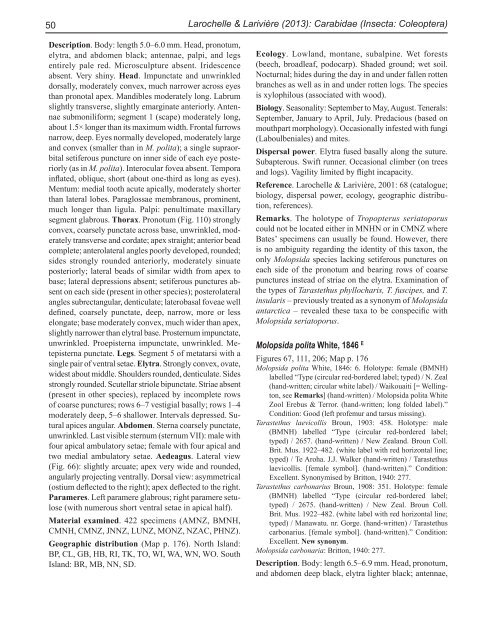Fauna of New Zealand 69 - Landcare Research
Fauna of New Zealand 69 - Landcare Research
Fauna of New Zealand 69 - Landcare Research
You also want an ePaper? Increase the reach of your titles
YUMPU automatically turns print PDFs into web optimized ePapers that Google loves.
50<br />
Description. Body: length 5.0–6.0 mm. Head, pronotum,<br />
elytra, and abdomen black; antennae, palpi, and legs<br />
entirely pale red. Microsculpture absent. Iridescence<br />
absent. Very shiny. Head. Impunctate and unwrinkled<br />
dorsally, moderately convex, much narrower across eyes<br />
than pronotal apex. Mandibles moderately long. Labrum<br />
slightly transverse, slightly emarginate anteriorly. Antennae<br />
submoniliform; segment 1 (scape) moderately long,<br />
about 1.5× longer than its maximum width. Frontal furrows<br />
narrow, deep. Eyes normally developed, moderately large<br />
and convex (smaller than in M. polita); a single supraorbital<br />
setiferous puncture on inner side <strong>of</strong> each eye posteriorly<br />
(as in M. polita). Interocular fovea absent. Tempora<br />
inflated, oblique, short (about one-third as long as eyes).<br />
Mentum: medial tooth acute apically, moderately shorter<br />
than lateral lobes. Paraglossae membranous, prominent,<br />
much longer than ligula. Palpi: penultimate maxillary<br />
segment glabrous. Thorax. Pronotum (Fig. 110) strongly<br />
convex, coarsely punctate across base, unwrinkled, moderately<br />
transverse and cordate; apex straight; anterior bead<br />
complete; anterolateral angles poorly developed, rounded;<br />
sides strongly rounded anteriorly, moderately sinuate<br />
posteriorly; lateral beads <strong>of</strong> similar width from apex to<br />
base; lateral depressions absent; setiferous punctures absent<br />
on each side (present in other species); posterolateral<br />
angles subrectangular, denticulate; laterobasal foveae well<br />
defined, coarsely punctate, deep, narrow, more or less<br />
elongate; base moderately convex, much wider than apex,<br />
slightly narrower than elytral base. Prosternum impunctate,<br />
unwrinkled. Proepisterna impunctate, unwrinkled. Metepisterna<br />
punctate. Legs. Segment 5 <strong>of</strong> metatarsi with a<br />
single pair <strong>of</strong> ventral setae. Elytra. Strongly convex, ovate,<br />
widest about middle. Shoulders rounded, denticulate. Sides<br />
strongly rounded. Scutellar striole bipunctate. Striae absent<br />
(present in other species), replaced by incomplete rows<br />
<strong>of</strong> coarse punctures; rows 6–7 vestigial basally; rows 1–4<br />
moderately deep, 5–6 shallower. Intervals depressed. Sutural<br />
apices angular. Abdomen. Sterna coarsely punctate,<br />
unwrinkled. Last visible sternum (sternum VII): male with<br />
four apical ambulatory setae; female with four apical and<br />
two medial ambulatory setae. Aedeagus. Lateral view<br />
(Fig. 66): slightly arcuate; apex very wide and rounded,<br />
angularly projecting ventrally. Dorsal view: asymmetrical<br />
(ostium deflected to the right); apex deflected to the right.<br />
Parameres. Left paramere glabrous; right paramere setulose<br />
(with numerous short ventral setae in apical half).<br />
Material examined. 422 specimens (AMNZ, BMNH,<br />
CMNH, CMNZ, JNNZ, LUNZ, MONZ, NZAC, PHNZ).<br />
Geographic distribution (Map p. 176). North Island:<br />
BP, CL, GB, HB, RI, TK, TO, WI, WA, WN, WO. South<br />
Island: BR, MB, NN, SD.<br />
Larochelle & Larivière (2013): Carabidae (Insecta: Coleoptera)<br />
Ecology. Lowland, montane, subalpine. Wet forests<br />
(beech, broadleaf, podocarp). Shaded ground; wet soil.<br />
Nocturnal; hides during the day in and under fallen rotten<br />
branches as well as in and under rotten logs. The species<br />
is xylophilous (associated with wood).<br />
Biology. Seasonality: September to May, August. Tenerals:<br />
September, January to April, July. Predacious (based on<br />
mouthpart morphology). Occasionally infested with fungi<br />
(Laboulbeniales) and mites.<br />
Dispersal power. Elytra fused basally along the suture.<br />
Subapterous. Swift runner. Occasional climber (on trees<br />
and logs). Vagility limited by flight incapacity.<br />
Reference. Larochelle & Larivière, 2001: 68 (catalogue;<br />
biology, dispersal power, ecology, geographic distribution,<br />
references).<br />
Remarks. The holotype <strong>of</strong> Tropopterus seriatoporus<br />
could not be located either in MNHN or in CMNZ where<br />
Bates’ specimens can usually be found. However, there<br />
is no ambiguity regarding the identity <strong>of</strong> this taxon, the<br />
only Molopsida species lacking setiferous punctures on<br />
each side <strong>of</strong> the pronotum and bearing rows <strong>of</strong> coarse<br />
punctures instead <strong>of</strong> striae on the elytra. Examination <strong>of</strong><br />
the types <strong>of</strong> Tarastethus phyllocharis, T. fuscipes, and T.<br />
insularis – previously treated as a synonym <strong>of</strong> Molopsida<br />
antarctica – revealed these taxa to be conspecific with<br />
Molopsida seriatoporus.<br />
Molopsida polita White, 1846 E<br />
Figures 67, 111, 206; Map p. 176<br />
Molopsida polita White, 1846: 6. Holotype: female (BMNH)<br />
labelled “Type (circular red-bordered label; typed) / N. Zeal<br />
(hand-written; circular white label) / Waikouaiti [= Wellington,<br />
see Remarks] (hand-written) / Molopsida polita White<br />
Zool Erebus & Terror. (hand-written; long folded label).”<br />
Condition: Good (left pr<strong>of</strong>emur and tarsus missing).<br />
Tarastethus laevicollis Broun, 1903: 458. Holotype: male<br />
(BMNH) labelled “Type (circular red-bordered label;<br />
typed) / 2657. (hand-written) / <strong>New</strong> <strong>Zealand</strong>. Broun Coll.<br />
Brit. Mus. 1922–482. (white label with red horizontal line;<br />
typed) / Te Aroha. J.J. Walker (hand-written) / Tarastethus<br />
laevicollis. [female symbol]. (hand-written).” Condition:<br />
Excellent. Synonymised by Britton, 1940: 277.<br />
Tarastethus carbonarius Broun, 1908: 351. Holotype: female<br />
(BMNH) labelled “Type (circular red-bordered label;<br />
typed) / 2675. (hand-written) / <strong>New</strong> Zeal. Broun Coll.<br />
Brit. Mus. 1922–482. (white label with red horizontal line;<br />
typed) / Manawatu. nr. Gorge. (hand-written) / Tarastethus<br />
carbonarius. [female symbol]. (hand-written).” Condition:<br />
Excellent. <strong>New</strong> synonym.<br />
Molopsida carbonaria: Britton, 1940: 277.<br />
Description. Body: length 6.5–6.9 mm. Head, pronotum,<br />
and abdomen deep black, elytra lighter black; antennae,
















